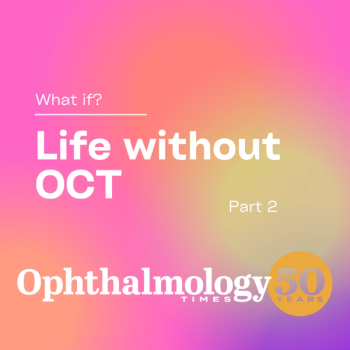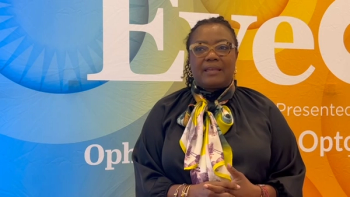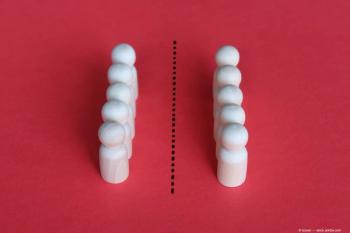
A post hoc analysis of the phase 2/3 PHOTON trial
Sean Adrean, MD, FAAO, sat down with Ophthalmology Times to discuss a post hoc analysis of the phase 2/3 PHOTON trial and the outcomes of patients with DME and baseline BCVA of 20/50 or worse or 20/40 or better who were treated with aflibercept 8 mg and 2 mg.
Sean Adrean, MD, FAAO, sat down with Ophthalmology Times to discuss a post hoc analysis of the phase 2/3 PHOTON trial and the outcomes of patients with DME and baseline BCVA of 20/50 or worse or 20/40 or better who were treated with aflibercept 8 mg and 2 mg.
Video Transcript:
Editor's note: The below transcript has been lightly edited for clarity.
David Hutton:
I'm David Hutton of Ophthalmology Times. The Association for Research in Vision and Ophthalmology recently concluded its annual meeting in Seattle. At that meeting, Dr. Sean Adrean presented "Outcomes of patients with diabetic macular edema and baseline best corrected visual acuity of 20/50 or worse, or 20/40 or better, who were treated with aflibercept 8mg and 2mg. A post-hoc analysis of the Phase 2/3 PHOTON trial." Thank you so much for joining us today. Tell us about your presentation.
Sean Adrean, MD, FAAO:
Thank you for having me. So this presentation had its genesis in Protocol-T. Protocol-T looked at aflibercept ranibizumab, and bevacizumab, quite a few years ago, and looked at how patients did and saw that those patients that had 20/50 or worse vision did quite a bit better with 2mg aflibercept. And those patients that had 20/40 or better vision actually did pretty decently between those three different medication anti-VEGF agents used. So with the onset of 8mg aflibercept, we wanted to look at see how these patients did in the diabetic macular edema population and against kind of splitting their vision into 20/50 or worse, or 20/40 or better. And in this case, we're comparing the 8mg aflibercept with the 2mg aflibercept. The other thing that we're interested in was to see whether or not extended time intervals could be allowed and see how patients would do if they're going longer than that 8 weeks, but maybe going out to 12 or 16 weeks, and would those patients be able to maintain dosing. Either if they're 20/50 or worse, or 20/40 or better.
The other thing that we're curious about is how would their response be for their central macular thickness as well in this population. So at baseline, these patients were pretty well randomized in the different arms between the 2mg aflibercept, the 8mg aflibercept at every 12 weeks, and the 8mg aflibercept every 16 weeks. And the [8mg every 12 weeks], they were randomized, twice as many. So it was one one group would have, at the 2mg aflibercept, it was like one portion of the patient population versus 2 in the 8mg q12 weeks versus one portion of the population in the Aq16 week. And what is also the thing that was interesting with this patient population is that about 40% of these patients had been previously treated for diabetic macular edema.
So that means that the patient population was a little bit more difficult to treat. And so when we went ahead and looked at the different analysis based on these two different subgroups, we found that those patients that had the 8mg either in the 12 or the 16-week dosing intervals, had just excellent vision compared with the 2mg aflibercept at the every 8 week time intervals. The 8mg dosage got 3 loading doses versus the 2mg that got 5 loading doses.
And thankfully, those patients had very similar visual outcomes. And there was no statistical difference between those two different groups, which was great. And while those patients had the 8mg done every 12 or 16 weeks, for those patients that were 20/50 or worse, a good 90% approximately of those patients were able to maintain those extended dosing intervals. And when they were 20/40 or better, they were about 98%, were able to maintain those extended dosing intervals, which is great.
And the other thing that we found was that as you would expect it those patients that had 20/50 or worse vision, they had a bigger visual response. So they gained more letters, about 10 letters in all 3 different treatment arms. Versus those patients that were 20/40 or better, they had about a 6-letter gain. But and you'd expect that because you'd have a little bit of a ceiling effect for those patients that had 20/40 or better. And also the those patients that are 20/50 or worse had thicker retinas. And those retinas thinned out more. So they had a larger reduction in their central macular thickness when compared to the 20/40 group. So, in all these patients did very well with these different treatments as with the extended time intervals.
David Hutton:
What's the next step for this research?
Sean Adrean, MD, FAAO:
That's a great question. So this is the one-year data so we look forward to presenting the two-year data at the upcoming American Academy of Ophthalmology meeting looking at these different subgroups. Because we're able to find that these patients are able to go these extended time intervals. And in the two-year data, some of these patients will be out at 20 or 24 weeks, and it'll be exciting to see how these patients do over time with even further extended time interval dosing.
David Hutton:
Ultimately, what can this mean for ophthalmologists? And how can it help them give better outcomes for their patients?
Sean Adrean, MD, FAAO:
Well, as we know, having increased treatment burden for both the patient and for the physician, where patients require, you know, every 4, every 8-week dosing is a large burden on the patients and patients caregiver and on our clinic. So if we're able to start extending these patients out and they can have similar visual outcomes, and do very well controlling their disease process and they're able to go out 16/20/24 weeks, then by reducing that treatment burden, we're going to really be able to help our patients
Newsletter
Don’t miss out—get Ophthalmology Times updates on the latest clinical advancements and expert interviews, straight to your inbox.


















































.png)


